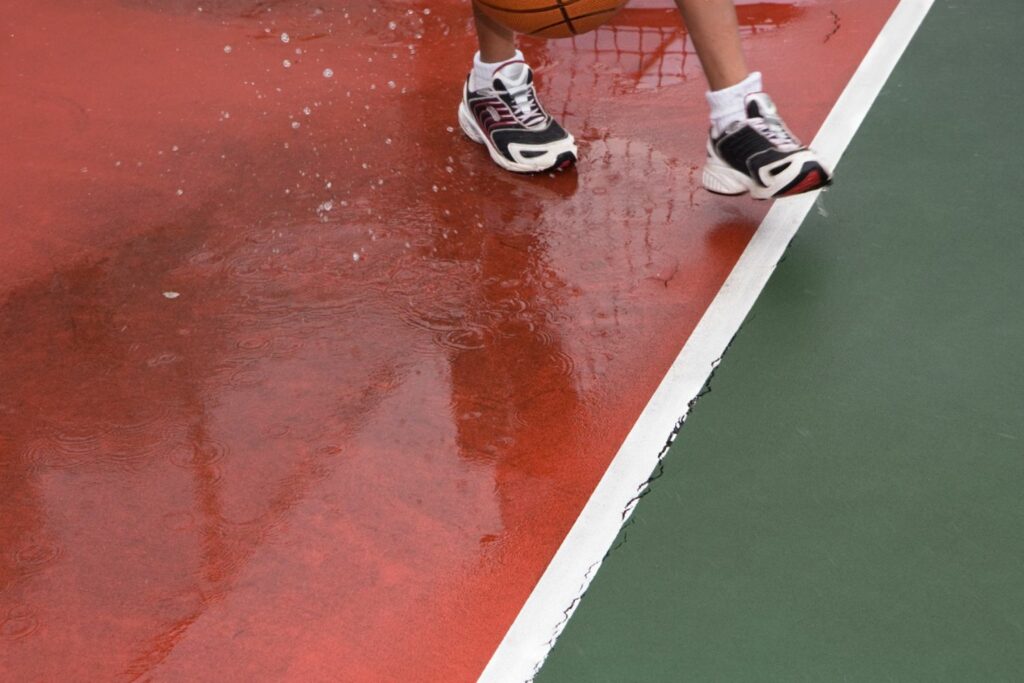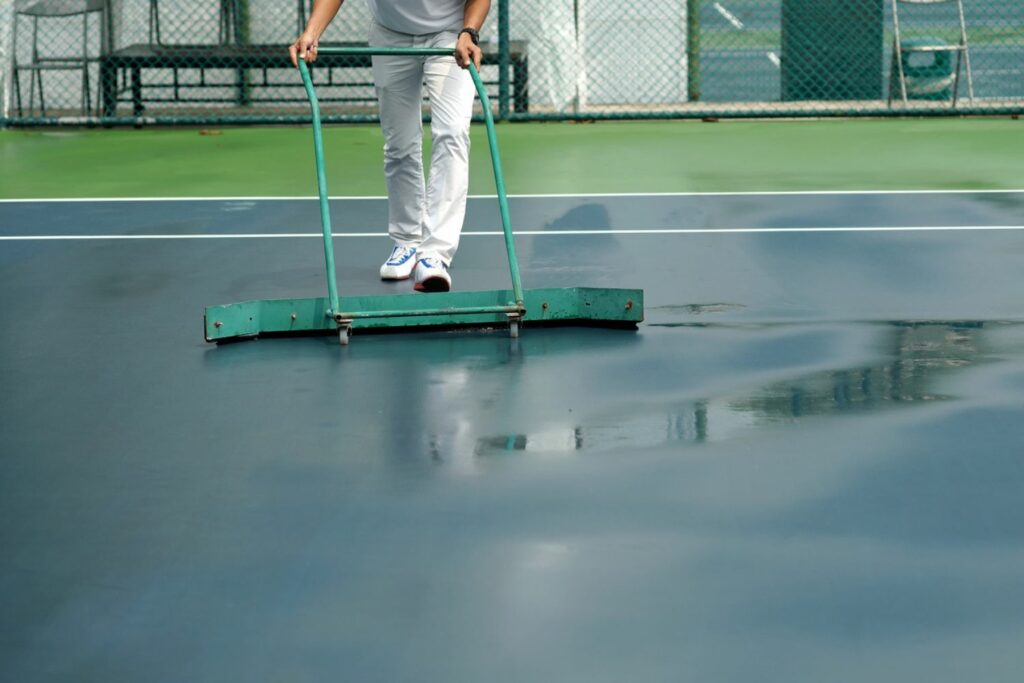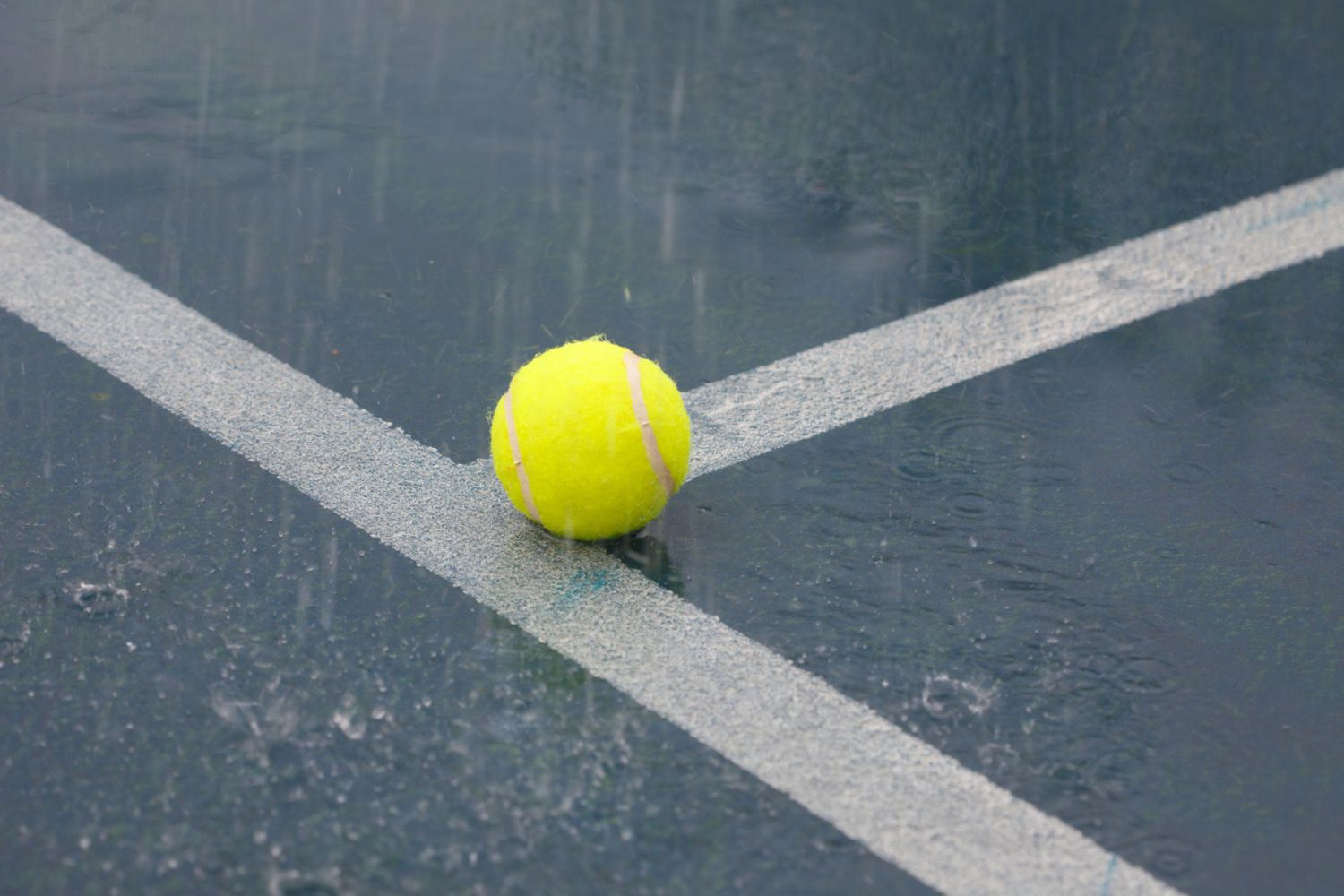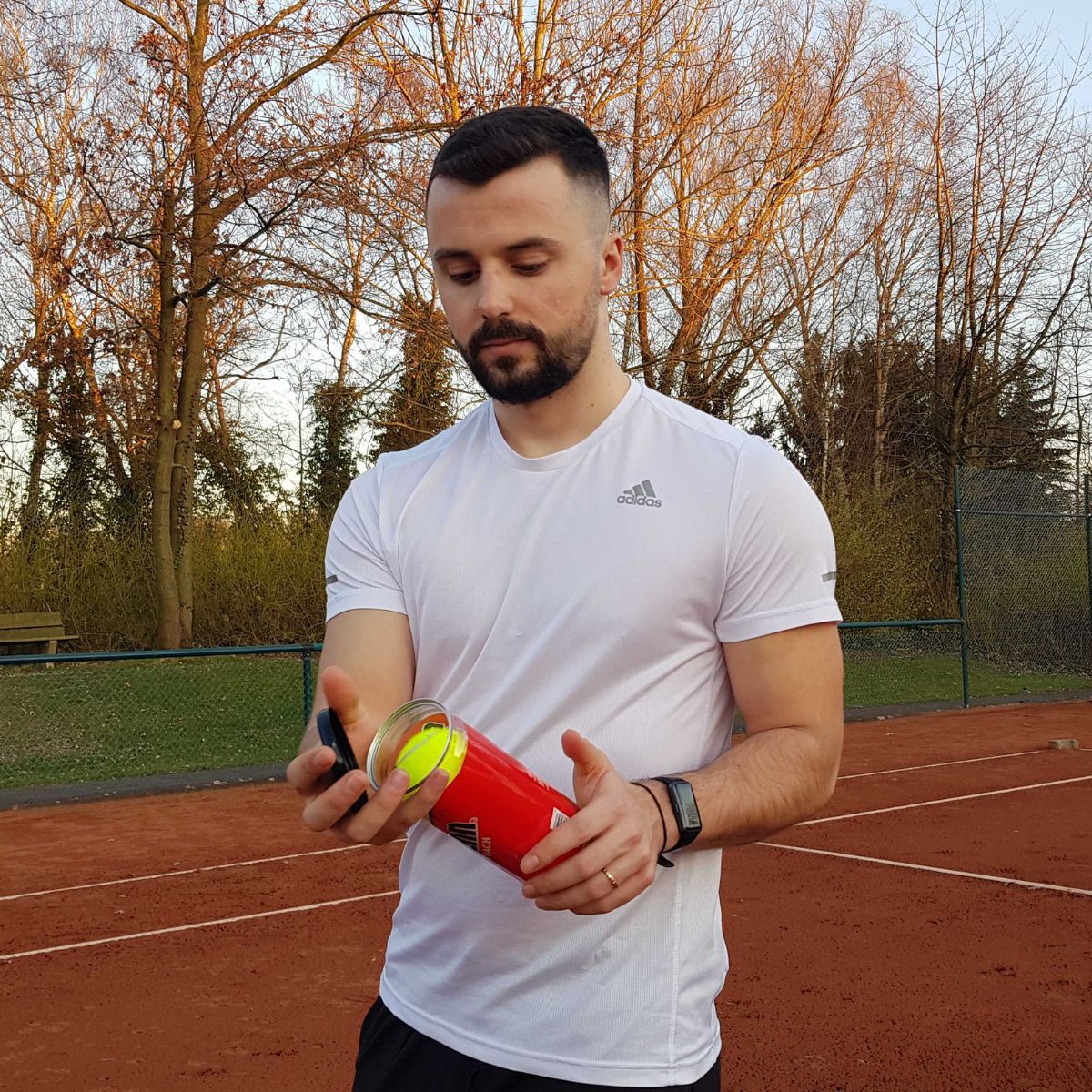There is nothing better than playing tennis on a nice sunny day, but the truth is that the weather conditions are not always ideal, especially for players leaving in cold climates that have to deal with frequent rainfalls constantly. However, this should not stop you, it is entirely possible to play tennis in the rain, and in this guide, I’ll explain everything you need to know to keep yourself safe, get the workouts in, and still enjoy the game.
It’s normal to feel insecure and not be your best performance when playing on a wet court, but you can adapt with the right techniques and lots of practice. Those trained to play tennis in the rain usually find themselves thriving in winter championships, turning their obstacles to their main advantage. You can do it, too, so keep scrolling to learn how.
Can You Play Tennis in The Rain?
Yes, you can play tennis in the rain depending on how heavy the rain is, the type of surface, and how comfortable you are playing on a wet court. Rain will affect your rhythm and stability, so you must be extra careful. If you don’t feel comfortable or safe, don’t do it.
Can You Play Tennis on a Wet Court?
Yes, you can play tennis on a wet court, but the surface type matters. Clay courts are the best type because they are meant to be slightly wet all the time. Hard courts are the second-best choice, while grass-court tend to be slippery during rain; you better avoid them not to risk injury.

Tips for Playing Tennis in Rain
Playing tennis in the rain doesn’t have to be a mission impossible. With these simple tips and tricks, you can adapt in no time to wet weather conditions
1. Bend your knees more.
As obvious as it sounds, please don’t neglect this. In wet courts, tennis ball tends to bounce much lower; that’s why it’s important to bend your knees more than usual to get down to the ball and hit even at difficult angles. It will help to find your pace and probably put you an advantage over your opponent since most players tend to forget this.
2. Step up your volley game.
Playing in the rain might be difficult for you, but the same goes for your opponent as well. So why not take advantage of it? Instead of hitting groundstrokes in long rallies, step up your volley game, and stay closer to the net more. You’ll save yourself some energy, avoid running on a wet field as much and avoid a dangerous slip.
It will be easier and faster to close a point too. Even if you are an aggressive baseliner, by stepping up your volley game, you’ll get to confuse your opponent, who would take longer to adapt to your new game style. It’s still a win-win situation, so go for it.
3. Avoid kick serves.
You’ll probably hate this tip if kick serves are your master skill, but they just are not the same when playing tennis in the rain. “The magic” of a kick serves is on the ball’s high bounce, but on a wet court, that doesn’t happen. It will probably end up on your opponent’s strike zone, and you’ll end up being crushed during returns.
4. Modify your groundstrokes.
Lower bouncing balls are always expected when playing tennis in the rain, so you have to adapt your game style. You can still use this to your advantage, especially if your opponent is more of a “power player.” On a wet court, the pace of the shots will slow down, giving you more time in returns. If you have mastered sliced shots, use them because they naturally don’t bounce high; you’ll have a better chance of closing the points fast and frustrating your opponent.
4. Master your side slides.
On a wet court, your tennis shoes won’t have the best grip, no matter how good they are. That means only one thing; more footwork for you. Side slides can be your best friend when playing tennis in the rain because they will make you more comfortable and confident. Mastering slides will take your tennis game to a whole new level; this is very useful when playing on clay or grass courts, even in dry weather.
5. Make your opponent move.
Be as aggressive as you can, and make your opponent move. Not just side to side, back to forth also, in all areas of the court. Playing tennis in the rain limits players’ movement and stability, so their reaction and performance most likely won’t be at their best. Drop shots can be an absolute killer on the game and the most effective to exhaust your opponent. It is the best way to close the points and win the game.

How to Avoid Injuries When Playing Tennis in the Rain
You probably wonder by now if it is safe to play tennis in the rain? Well, the answer is not as simple, and I urge you to avoid possible injuries. Listed below, you have some important tips that will make your experience on a wet court easier.
- Be careful of traction changes. When playing tennis in the rain, your tennis shoes will not feel or perform the same. Their traction can change depending on how old the shoes are and on what type of surface you are playing with. The material of clay courts can end up in the bottom’s patterns, while in the hard court, the change of traction can make you slip and even hurt yourself. If the rain is very heavy and you are not sure if you can handle the game, please just don’t play.
- Stay warm. Playing tennis in cold weather means you should always take extra measures to keep yourself warm. Catching a cold can lead up to various health complications, such as common flue and high body temperature. But it can also lead to pulling a muscle or some serious injury when you slip on the court. Make sure not to forget that extra jacket.
- Hydrate. Just because it’s raining doesn’t mean your body is hydrated, increasing the risk of injury. Always make sure to keep your water bottle close and take the daily amount of water doctors and your coach recommend.
- Keep your racket dry. Wipe up your grip as often as you can with a towel to keep it dry. This way, you’ll avoid painful blisters and, worse, a wrist injury.
- Beware of the ball. The material of tennis balls can absorb moisture, making them heavier in weight. Wet tennis balls can be dangerous, especially during a fast, powerful shot, which can even lead to an injury. Switch the balls whenever you find it necessary; you can dry them later at your home.
- Watch out for the court’s lines. Those are the most slippery. You can’t totally avoid them, but you can stay in the mid of the court whenever you are running on the baseline or sliding across different sides of the field.
- Avoid half wet courts. Those are the most dangerous when playing tennis in the rain. It might seem a little confusing, but half-wet courts are quite difficult to play in unless you have years of experience. If you hit a sudden dry patch on the court, it will make your shoes grip the surface suddenly, which will make you fall. Sudden wet patches are also dangerous because you’ll find yourself sliding unintentionally and might twist an ankle in the process.
- Postpone the match. Sometimes the best way to avoid a bad injury is by simply choosing to play another day. Don’t be afraid to postpone your game if the rain is too heavy, the court isn’t safe, or you just don’t feel comfortable enough playing in the rain.
- Wear appropriate clothing. Knowing what to wear when playing tennis in the rain is also important. Try wearing long sleeves and pants, as well as a headband to keep the rain out of your eyes. I also recommend wearing something light, like a windbreaker, that will let you move freely in the court. Make sure to wear socks that will absorb sweat and won’t slip in your shoes.
FAQs
As long as you know how to play tennis in the rain, you can have a good time and even improve your game. Here are some of the most asked questions on this topic.
Q: How long does it take tennis courts to dry after heavy rain?
The amount of time it takes for a tennis court to dry after heavy rain depends on several factors. Most notably, the type of surface affects how long it will take for the courts to become playable again. On average, it typically takes at least one hour before a regular hard-court surface is dry enough to resume play.
However, clay courts tend to need even more time than that depending on their construction and soil drainage. On clay courts with significant waterlogging or poor drainage, it can take up to several hours before they are ready for use – sometimes even over 6 hours! Additionally, weather conditions like wind and sunlight will affect the rate at which the court dries as well.
Q: Does tennis get canceled in the rain?
Absolutely! Tennis can be canceled in the event of rain. The rules governing tennis state that if there is any inconvenience due to bad weather, such as rain or strong winds, the matches should stand as played. This means that players are required to wait at the court and continue playing until the match is completed – regardless of the condition of play.
However, it should also be noted that tournaments may have specific regulations pertaining to suspension or cancellation based on weather conditions. For example, many professional tournaments will suspend play during light showers if a number of matches have already been delayed by more than an hour. In addition, some tournaments allow players to mutually agree to cancel a match due to adverse weather conditions before it starts, and no score is officially recorded.
Q: What is the best tennis surface for rain?
When it comes to the best tennis surface for rain, porous cushioned acrylic is an ideal choice. This type of surface provides players with better traction and reduces the risk of slipping on wet courts. It also absorbs up to 33% more water than hard court surfaces, making it far less slippery during wet weather. Because this type of surface features a raised bed design which improves ball bounce and control on wet courts, porous cushioned acrylic stands out as being one of the top choices when playing in rainy conditions.
Q: Is it OK for tennis balls to get wet?
Yes, rain can indeed ruin a tennis racket. When exposed to constant rain or water, the strings on a tennis racket will start to loosen and deteriorate. This places extra strain on the frame of the racket, which can affect its performance in terms of power and responsiveness – not ideal when you’re in the zone trying to get that winning shot! Furthermore, rainy conditions also generate moisture on your racket grip, which may cause it to become slippery throughout the play.

